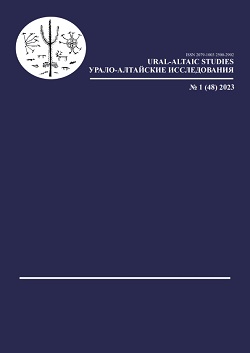Релятивизация в малокарачкинском говоре чувашского языка. К типологии обобщенных приименных клаузальных конструкций
Relativization in the Maloe Karachkino Dialect of Chuvash. On the Typology of General Noun-Modifying Clause Constructions
Author(s): Natalia N. LogvinovaSubject(s): Syntax, Semantics, Turkic languages
Published by: Институт языкознания Российской академии наук
Keywords: Chuvash language; dialectology; relativization; nominal modification; noun; semantics; syntax;
Summary/Abstract: The article analyzes features of relativization in Maloe Karachkino dialect of Chuvash (> Bulgar > Turkic). The elicitation data (collected by the author in a series of field trips from 2018 to 2020) shows that the gap strategy [Comrie, Kuteva 2005] is the main relativization mechanism in Maloe Karachkino dialect, and the syntactic restrictions on the relativized position are very weak. More precisely, only the positions of caritive object and object of comparison are not available for relativization. Otherwise, Maloe Karachkino dialect covers almost the entire Accessibility Hierarchy [Keenan, Comrie 1979]. At the same time, the success of relativization often depends on the naturalness of the connection between the predicate and the argument in the target position. The weakness of purely syntactic restrictions and the reliance on pragmatic naturalness give grounds to consider the Maloe Karachkino’s data in the context of the theory of General noun-modifying clause constructions (GNMC) [Matsumoto et al. 2017]. Maloe Karachkino dialect then occupies an intermediate position in the GNMC typology, since it shows identical design of relative clauses and noun-modifying sentential complements, but only limitedly allows frame constructions, which are supposed to be diagnostic of GNMC. However, as shown in the article, there are certain syntactic differences between relativization clauses and nominal sentential complements. In addition, the revision of the existing literature on the GNMC phenomenon, indicates that frame constructions are usually not described for the Turkic languages. Moreover, a more detailed analysis of the constructions for relativization and complementation reveals the non-identity of these structures in all languages where any diagnostics were carried out. Thus, the data of the Maloe Karachkino dialect contributes to the typology of phenomena that have recently been united under the term of GNMC. The data of this and some other idioms show that GNMC phenomenon turns out to be much less homogeneous than it is proposed to consider in [Matsumoto et al. 2017].
Journal: Урало-алтайские исследования
- Issue Year: 2023
- Issue No: 01 (48)
- Page Range: 70-90
- Page Count: 21
- Language: Russian

